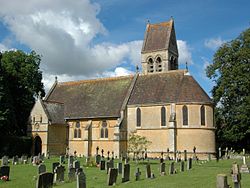Freeland
| Freeland | |
| Oxfordshire | |
|---|---|
 St Mary the Virgin parish church | |
| Location | |
| Grid reference: | SP414127 |
| Location: | 51°48’43"N, 1°24’3"W |
| Data | |
| Population: | 1,560 (2011) |
| Post town: | Witney |
| Postcode: | OX29 |
| Dialling code: | 01993 |
| Local Government | |
| Council: | West Oxfordshire |
| Parliamentary constituency: |
Witney |
| Website: | Freeland Village Website |
Freeland is a village about four miles north-east of Witney in Oxfordshire; a place with a population of 1,560 recorded at the 2011 census.
History
Freeland village began as part of the parish of Eynsham.[1] Its name is derived from the common Old English word fyrþ, meaning a wood.[2] In 1150 the Abbot of Eynsham granted land called terra de Frithe to one Nicholas of Leigh.[3] "Frith Wood" later evolved into "Thrift Coppice" and by 1241 several people were living there.[1] Freeland developed from a mediæval freehold, probably on the site of Elm Farm.[1]
The freehold farm was called Frithlands by the 16th century and had been joined by at least two other cottages before 1650.[1] there were something fewer than a dozen cottages at Freeland by 1762.[1] The enclosure of the parish of Eynsham was resisted by rioting in the north of the parish around Barnard Gate and Freeland in 1780 but was eventually carried out in 1784.[3]

The Roslyn house was established in 1738 and reputed to have been a 19th-century pugilists' meeting place called the "Wrostling House".[1] Freeland had several public houses by the later part of the 18th century and one called the Royal Oak was recorded in 1836.[1] The New Inn was built by William Merry in 1842, sold to Morrells in 1846 and for most of the 19th century was Freeland's only public house.[1] Since 1974 it has been called the Oxfordshire Yeoman.[4] It is the only public house in Freeland.
Freeland Lodge was built for the Taunton family in 1807.[1] Most of the land on the west side of Wroslyn Road belonged to the family and was made into a park for the Lodge.[1] The Lodge is now Freeland House Nursing Home. The Taunton family had sold the Lodge by 1875–76,[1] when Marion Taunton had St Mary's House built as a home for retired governesses.[5] In 1952 a Church of England convent of the Community of Saint Clare moved to the house and in 1960 a Gothic Revival chapel designed by the architect Henry Gordon was added.[5]
Freeland grew as a ribbon development along the Via Regia between Eynsham and Charlbury.[6] By 1847 its community included seven farmers, two shopkeepers, a mason, a carpenter and the publican of the New Inn.[6] Freeland's population peaked at 232 in 1881 but fell to 160 in 1891, presumably as a result of the agricultural depression.[1] In 1932, when it was transferred from the civil parish of Eynsham to that of Hanborough, Freeland's population was 214.[1]
Chapel, Church and School

The parish church is St Mary The Virgin, a Gothic Revival church by John Loughborough Pearson. He also built the parsonage and parish school.[1] [5] The Taunton family paid for the church and parsonage to be built in 1869 and the school in 1871.[1]
The church includes 13th-century-style paintings of Jesus' Passion and Transfiguration.[5] Mears and Stainbank of the Whitechapel Bell Foundry cast four bells for St. Mary's in 1896.[7] The same foundry cast a new treble and second bells in 2010, completing the present ring of six.[7] The church clock was made and installed by Smiths of Derby in May 1898 and was dedicated to a Sarah Percival. In May 1969 the clock was taken down, reset and regilded by Judge Brothers of Oxford, and reinstalled by the local Breakspear family.
The parish is now part of the Benefice of Hanborough and Freeland.

Freeland Methodist Church was built as a Wesleyan chapel, completed in 1807.
The school, which was originally in an old stone house, next to the church on Wroslyn Road, moved to new premises in Parklands in 1964[1] and is now Freeland Church of England Primary School.
Society
Freeland has but one pub: The Oxfordshire Yeoman.
Freeland has had its own amateur orchestra.[10]
Freeland Nurseries is a family-run independent plant nursery and garden centre in the walled garden[11] of Freeland House. It has traded commercially since 1959.
Outside links
| ("Wikimedia Commons" has material about Freeland) |
References
- ↑ 1.00 1.01 1.02 1.03 1.04 1.05 1.06 1.07 1.08 1.09 1.10 1.11 1.12 1.13 1.14 1.15 Crossley & Elrington 1990, pp. 116–117.
- ↑ Rackham 1976, p. 198.
- ↑ 3.0 3.1 Emery 1974, p. 163.
- ↑ The Oxfordshire Yeoman
- ↑ 5.0 5.1 5.2 5.3 Sherwood & Pevsner 1974, p. 607.
- ↑ 6.0 6.1 Emery 1974, p. 164.
- ↑ 7.0 7.1 Davies, Peter (18 October 2010). "Freeland S Mary V". Dove's Guide for Church Bell Ringers. Central Council of Church Bell Ringers. http://dove.cccbr.org.uk/detail.php?searchString=Freeland&DoveID=Freeland. Retrieved 12 April 2011.
- ↑ Freeland Cricket Club
- ↑ Freeland Football Club
- ↑ Freeland Orchestra
- ↑ Freeland Nurseries
- A History of the County of Oxford - Volume 12 : {{{2}}} (Victoria County History) - Wootton Hundred (South) including Woodstock: on British History Online
- Emery, Frank: 'The Oxfordshire Landscape' - The Making of the English Landscape (Hodder & Stoughton, 1974) ISBN 0-340-04301-6 pages 162–164
- Rackham, Oliver: 'Trees and Woodland in the British Landscape' (Archaeology in the Field Series, 1976) ISBN 0-460-04183-5, page 108
- {Pevsner}}
- Webster, Gwen: 'The Search for Freeland Gardens (Warmporch Publishing, 2009)